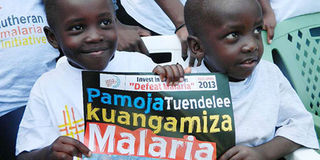Child deaths fall in Nyanza, western: study

Children from Diakonia Compassionate Ministry in Kisumu recite a poem to mark World Malaria Day celebrations in Ahero, Kisumu County, in 2013. The government is battling diseases such as malaria, which is a leading cause of death among young children. PHOTO | FILE | NATION MEDIA GROUP
What you need to know:
- Homa Bay had the worst mortality in 1965 at 269 deaths per 1,000, but reduced to 120 deaths per 1,000 in 2013, a 55 per cent decline.
- The formulae with which the government has been allocating funds historically perpetuates inequality, especially in regions that have historically leaned on the political opposition.
A new study reveals that the Nyanza and western regions have recorded the highest improvement in reducing under-five mortality since independence.
Research over the years has shown that the two regions are some of the deadliest places to be born, and a child is likely to die if born there unlike in parts of central Kenya.
The regions are known to be “friendlier” to several deadly diseases, with geography and cultural practices playing a key role.
These include being in the lake basin, where a warm and wet climate is a breeding ground for mosquitoes that carry the malaria-causing germ.
And since the early 1990s, the region’s four counties — Migori, Homa Bay, Kisumu and Siaya — bear more than 40 per cent of the country’s HIV burden, demographic health surveys show.
STATISTICS
However, the new study published by researcher Peter Macharia of Kemri-Wellcome Trust shows that the regions reduced the mortality of children under five by more than 70 per cent, while central managed a paltry 30 per cent.
Marshalling historical documents, and combining mathematical formulae superimposed over geographical locations, Dr Macharia reported that just after independence, “one in every seven Kenyan children born alive died before the age of five; 49 years later, mortality has declined significantly, but remains high, with one in every 19 children not reaching their fifth birthday.”
The mortality reduced from 142 per 1,000 live births in 1965 to 55 per 1,000 in 2013. This was 62 per cent, a remarkable improvement that also masked great inequalities.
Homa Bay had the worst mortality in 1965 at 269 deaths per 1,000, but reduced to 120 deaths per 1,000 in 2013, a 55 per cent decline.
Nyeri, on the other hand, had 54 deaths per 1,000 but only reduced the mortality by 20 per cent to 43.
Counties like Samburu, Marsabit, Elgeyo-Marakwet and Mandera still have undesirable statistics but had more than 70 per cent reduction in mortalities.
IMPEDIMENTS
The Sunday Nation collated all the diseases recorded in the census data since 1969 — the first — to 1999 and found that before independence, children battled polio, whooping cough and diphtheria.
Waterborne diseases like dysentery also featured prominently. High rates of HIV from the early 1990s, malaria and resistance to medication meant to treat the disease turned Nyanza and western to that vicious cycle of fatalities.
It did not help much that user fees - the money paid to the hospitals by patients - was introduced in health facilities in 1992.
Before independence, nearly a quarter of all children died before they turned five (250 deaths per 1,000 live births), and just slightly after independence, the number reduced to 239 per 1,000.
The worst places, the study pointed out, were coastal, arid and semi-arid counties, Lake Victoria and Turkana.
GLOBAL PLEDGE
In the development arena, under-five mortality is used as a yardstick to measure how healthy a country is, and how likely it is to meet its development targets.
In 1990, at the World Summit for Children, ministries of health all over the world agreed to reduce the deaths of children under five to less than 70 per 1,000 live births by the year 2000, or reduce them by one-third between 1990 and 2000.
Careful not to pin on one explanation, several theories have been fronted to explain these unfair differences.
Dr Kenneth Munge, an expert in health policy and systems expert, told the Sunday Nation the differences in the likelihood are inequities, as opposed to inequality, because “they are unfair and unjustifiable that one child in one location would fair way much better”.
Dr Munge says that the under-five mortality points to everything that is wrong in a child’s life, including outside the health system.
He says: “There have been links to a child’s survival on the mother, whether she feeds well, is educated or not, can access contraceptives so that she can space her children; on the household, whether they have food so they do not stunt, clean water so that they do not diarrhoea and die, among many other factors.”
PREJUDICE
In 2018, a study by the East Africa Institute (EAI) of Aga Khan University pointed out that the formulae with which the government has been allocating funds historically perpetuates inequality, especially in regions that have historically leaned on the political opposition.
Analysing data on the conditions on which poverty thrives — (il)literacy, maternal mortality, nutrition, a portion of the land that is fertile enough for farming and other factors — the study indicated that where Kenyans are placed determines whether or not they will be poor.
Dr Alex Awiti, the director of EAI, said that using the Commission on Revenue Allocation’s formula favours small “enabled” counties that are able to take care of themselves, and allows inequality to thrive.





